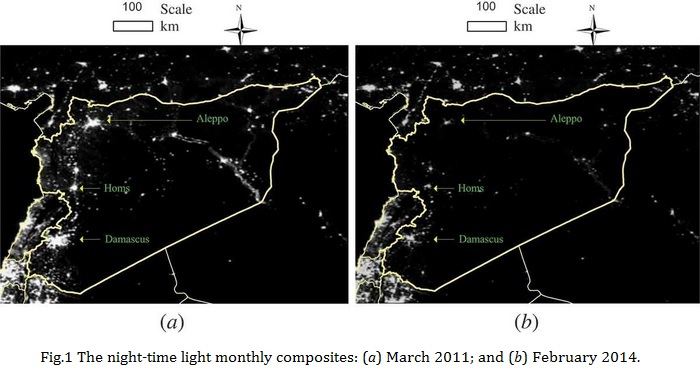Satellite images shed light, or lack thereof, on the impact of the Syrian conflict

The ongoing Syrian Crisis, which broke out in April 2011, has been a severe humanitarian disaster, with more than 190,000 deaths since the start of the conflict. However, evaluating the ongoing crisis in Syria is challenging, because reliable and comprehensive witness reports are hard to gather in a warzone. Therefore, satellite images, as one of the few sources of objective information, are potentially of great importance.
In their recent study published in International Journal of Remote Sensing, Xi Li and Deren Li analysed the effect of the Syrian Crisis on levels of night-time light as a means of evaluating and monitoring the conflict. By comparing the levels of light in March 2011 and February 2014, (see Fig 1. attached) they found that in all of the provinces, the levels of night-time light had declined sharply following the breakout of the conflict. Indeed, in most provinces, the level of night-time light decreased by more than 60%.
Notably, the authors also found that the number of internally displaced persons (IDPs) from each province showed a linear correlation with the level of night-light loss. This relationship between the number of displaced persons and the drop in night-time light levels may allow for the quantitative estimation of the number of IDPs from other areas of conflict, such as Iraq, where the activities of Islamic State are causing significant civil unrest.
To find out more, please access the full article, free of charge, online at: http://www.tandfonline.com/doi/full/10.1080/01431161.2014.971469
Dr. Xi Li and Prof. Deren Li are with the State Key Laboratory of Information Engineering in Surveying, Mapping and Remote Sensing, Wuhan University, China. Dr. Xi Li is also currently a visiting scientist at the Department of Geographical Sciences, University of Maryland at College Park, MD, USA. Dr. Xi Li can be reached at +1-973-4247293 (mobile) or +1-301- 314-2585 (office).
For more information please contact:
Alan Crompton
Earth Science, Geography, GIS, Palaeontology, Remote Sensing and Water Science Journals, Taylor & Francis
Contact email: alan.crompton@tandf.co.uk
About Taylor & Francis Group
Taylor & Francis Group partners with researchers, scholarly societies, universities and libraries worldwide to bring knowledge to life. As one of the world’s leading publishers of scholarly journals, books, ebooks and reference works our content spans all areas of Humanities, Social Sciences, Behavioural Sciences, Science, and Technology and Medicine.
From our network of offices in Oxford, New York, Philadelphia, Boca Raton, Boston, Melbourne, Singapore, Beijing, Tokyo, Stockholm, New Delhi and Johannesburg, Taylor & Francis staff provide local expertise and support to our editors, societies and authors and tailored, efficient customer service to our library colleagues.
Tags:


